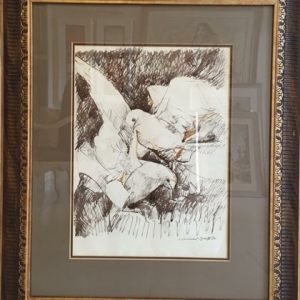Artistic Journey
Born in 1939 in Kairana, India, Jamil Naqsh migrated to Pakistan following the partition in 1947. His formal artistic training began at the National College of Arts (then Mayo School of Arts) in Lahore, but he left before graduation to study the traditional miniature painting techniques directly from Ustad Mohammad Sharif.
This unconventional education deeply influenced his artistic development, as he merged classical techniques with modernist sensibilities. Naqsh's early years were marked by intense study of both Eastern miniature traditions and Western masters like Picasso and Cézanne, creating a unique visual language that bridged cultural traditions.
Throughout his career, Naqsh consistently explored certain recurring themes and motifs—women, pigeons, horses, and calligraphy—each laden with personal and cultural significance. His work evolved continuously while maintaining a distinctive style that made him immediately recognizable in the contemporary art world. Jamil Naqsh passed away in May 2019 in London, leaving behind an extraordinary legacy that continues to influence artists across South Asia and beyond.
Education
National College of Arts, Lahore (studies not completed)
Apprenticeship under Ustad Mohammad Sharif (master miniaturist)
Awards
Pride of Performance Award, Government of Pakistan (1989)
Sitara-i-Imtiaz (Star of Excellence), Government of Pakistan (2009)
Lifetime Achievement Award, Arts Council of Pakistan (2003)
Style & Medium
Jamil Naqsh's work is characterized by a fusion of traditional miniature techniques with modernist composition. He worked primarily with oil on canvas, creating figurative works with a distinctive palette and ethereal quality. His masterful handling of form, especially the female figure, and his symbolic inclusion of pigeons, horses, and calligraphy created a unique visual vocabulary that is immediately recognizable.
